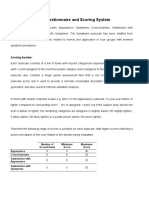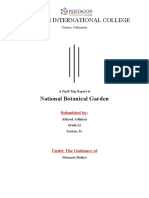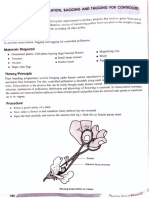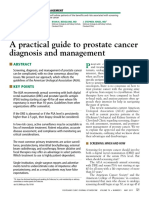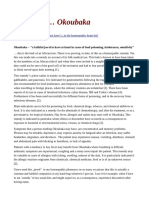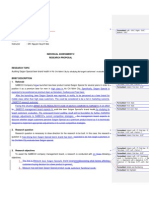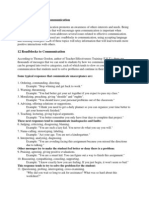Professional Documents
Culture Documents
Florigen Concept Botany
Florigen Concept Botany
Uploaded by
Paramartha BanerjeeOriginal Description:
Original Title
Copyright
Available Formats
Share this document
Did you find this document useful?
Is this content inappropriate?
Report this DocumentCopyright:
Available Formats
Florigen Concept Botany
Florigen Concept Botany
Uploaded by
Paramartha BanerjeeCopyright:
Available Formats
Topic: PHOTOPERIODISM
Course Title: PLANT PHYSIOLOGY AND METABOLISM
Paper: BOT-G-CC-4-4-TH
Unit: 8
Semester: IV
Name of the Teacher: Mrs. Rinku Halder Sahu
Name of the Department: Botany (Morning)
Perception of the Photoperiodic Stimulus and Presence of a Floral
Hormone:
It is now well established that the photoperiodic stimulus is perceived
by the leaves. As a result, a floral hormone is produced in the leaves
which is then translocated to the apical tip, subsequently causing the
initiation of floral primordia.
That the photoperiodic stimulus is perceived by the leaves can be shown
by simple experiments on cocklebur (Xanthium pennsylvanicum), a short
day plant.
● Cocklebur plant will flower if it has previously been kept under
short-day conditions (Fig. 18.2 A).
● If the plant is defoliated and then kept under short day condition, it will
not flower (Fig. 18.2 B).
● Flowering will also occur even if all the leaves of the plant except one
leaf have been removed (Fig. 18.2 C).
● If a cocklebur plant, whether intact or defoliated, is kept under long
day conditions it will not flower (Fig. 18.2 D, E).
● But, if even one of its leaves is exposed to short day conditions and
the rest are under long day photoperiods, flowering will occur (Fig.
18.2 F).
The photoperiodic stimulus can be transmitted from one branch of
the plant to another branch. For example,
● If in a two branched cocklebur plant one branch is exposed to short
day and other to long day photoperiod, flowering occurs on both the
branches (Fig. 18.3 A).
● Flowering also occurs if one branch is kept under long day conditions
and another branch from which all the leaves except one have been
removed is exposed to short day condition (Fig. 18.3 B).
● However, if one branch is exposed to long photoperiod and the other
has been defoliated under short day condition, flowering will not occur
in any of the branches (Fig. 18.3 C).
Gibberellins and the Flowering Response:
It is often proposed that Pfr stimulates gibberellin production and this GA in
turn stimulates the production of floral hormone called florigen.
Importance of GA is due to the following effects of that hormone:
1. External GA can mimic the effect of red light in some cases.
2. GA prompts flowering in some LDPs under short day conditions,
mainly rosette plants which bolt before flowering.
3. GA also inhibits flowering in some SDPs.
4. Anti gibberellin nullifies the above effect of GA.
5. Natural GA from induced LDP also causes flowering in non induced
plants.
Although GA can induce flowering but they can not be considered to be the
primary floral hormone mainly because of the following reasons:
1. In LDPs, vegetative growth and differentiation of floral primordia
occur simultaneously but GA on the other hand first stimulates
vegetative growth (bolting) and then only floral primordia are
formed.
2. GAs have been unable to induce flowering in all short day
plants under a non inductive cycle.
Florigen concept:
A mobile molecule that is synthesized in leaves in response to the
favourable photoperiod and it migrates through the vascular system to the
apical meristem to promote floral initiation.
The name florigen has been proposed by Chailakhyan (1936) for the
unknown chemical stimulus acting as floral hormone. The significant
evidence of the existence of that substance comes from interspecific
grafting experiments.
Grafting experiment of florigen existence:
● Chailakhyan removed the leaves from the upper half of
Chrysanthemum (SDP) but left the leaves on lower half untouched.
● He then exposed the lower half to a short day- the plant did not
flower.
● He concluded that day length does not have an effect directly on the
buds but causes the leaves to manufacture a hormone that moves
from the leaves to the buds and induce flowering.
● He concluded that floral stimulus is translocated from the leaf of one
photo induced plant to another non photo induced plant.
● Florigen is believed to be synthesized in the photo induced leaf and
from there moved to the shoot apices for floral evocation , through
phloem.
Grafting experiments in cocklebur plants (Xanthium strumarium) have even
proved that the floral hormone can be trans located from one plant to
another. For example,
● if one branched cocklebur plant (Fig. 18.4 A) which has been
exposed to short day conditions is grafted to another cocklebur plant
kept under long day conditions, flowering occurs on both the plants
(Fig. 18.4 B).
● Obviously the floral hormone has been transmitted to the receptor
plant through graft union.
● But if a cocklebur plant is grafted to another similar plant both of
which have been kept under long day conditions, flowering will not
occur on either of the two plants (Fig. 18.4 C).
It has also been indicated that the floral hormone may be identical in
short-day and long- day plants. For example, grafting experiments between
certain long-day plants (eg: Silene armeria) and short-day plants( e.g:
Xanthium strumarium) have shown that flowering occurs on both the plants
even if one of them has been kept under non-inductive photoperiods.
But Hamner and Bonner (1938) tested about 246 different kinds of extracts
from SDPs, LDPs, and DNPs but none had any flower evoking effect in non
-inductive plants. So, it is believed that floral stimulus ( florigen) may have
several components which interact with one another in such a way that
some biochemical and cellular changes initiate floral primordia.
Chailakhyan later modified his florigen concept and proposed that
● Florigen is two hormones rather than one, a gibberellin and a
hypothetical hormone, he called anthesin.
● He suggested that LDPs can produce anthesin under any day length
but GA only under long days,
● SDPs can produce gibberellins under any day length but anthesin
only under short day,
● DNPs can produce both anthesin and GA in any day length.
● Thus a plant can flower only when both GA and anthesin are present.
According to a scheme proposed by Brian (1958), a gibberellin like
hormone is produced in the leaves during the photoperiod somewhat
as follows:
The precursor may be slightly stimulatory or inactive or antagonistic to the
gibberellin-like hormone. Red irradiations promote the conversion of the
precursor to the gibberellin-like hormone. In the dark there is a slow
reconversion of the gibberellin-like hormone to the precursor.
This reconversion is accelerated by far-red irradiations. It is further
presumed that high concentration of the gibberellin-like hormone leads to
the synthesis of florigen in long-day plants. In short-day plants the
synthesis of florigen takes place when the level of gibberellin-like hormone
is low. But, flowering eventually follows once the florigen synthesis has
taken place in both the cases.
The whole scheme is diagrammatically shown below:
Nature of the Floral Hormone:
Recent researches are indicative of ‘florigen’ to be a macromolecule unlike
other plant growth hormones which are rather small molecules. This
macromolecule may possibly be a RNA or protein molecule which is trans
located from the leaf to the apical tips (or meristems) via phloem in
photo-induced plants (Corbesier and Coupland, 2005).
In Arabidopsis thaliana, some researchers have identified this signal as
mRNA coded by the FLOWERING LOCUS T (FT) gene, others as the
resulting FT protein. First report of FT mRNA being the signal transducer
that moves from leaf to shoot apex. However, in 2007 another group of
scientists made a breakthrough saying that it is not the mRNA, but the FT
Protein that is transmitted from leaves to shoot, possibly acting as
"Florigen".
Here FT acts like a molecular “alarm-clock”, evoking a complex genetic
scenario, which culminates in flower formation.
You might also like
- MCQs From Cruciferae, Compositae, Graminae & MalvaceaeDocument5 pagesMCQs From Cruciferae, Compositae, Graminae & Malvaceaesajjan1506dbg8052100% (2)
- STD 12 Biology - Practical Record WorkDocument33 pagesSTD 12 Biology - Practical Record WorkGopika Ramesh100% (1)
- Biology Project - Herbarium On Medicinal PlantsDocument27 pagesBiology Project - Herbarium On Medicinal PlantsMAINAK MUKHERJEE78% (37)
- India As A Mega Diversity NationDocument14 pagesIndia As A Mega Diversity NationAshi Gupta72% (18)
- INVESTIGATORY Project - Dispersal of Seeds 1 (Final)Document27 pagesINVESTIGATORY Project - Dispersal of Seeds 1 (Final)Uma100% (3)
- Big Picture For Teacher Pdf-B2teach - CompressDocument22 pagesBig Picture For Teacher Pdf-B2teach - CompressErika GuerreroNoch keine Bewertungen
- Biology Investigatory ProjectDocument19 pagesBiology Investigatory ProjectRapidtg 1965100% (8)
- KARM (Phycoviruses)Document17 pagesKARM (Phycoviruses)KARM67% (3)
- Applications of NeopalynologyDocument11 pagesApplications of NeopalynologyAtika Amjad75% (16)
- 11th STD Botany Practical Manual English Medium - WWW - tn11th - in PDFDocument43 pages11th STD Botany Practical Manual English Medium - WWW - tn11th - in PDFsri thamizhan80% (85)
- Botany Multiple Choice Questions With AnswersDocument4 pagesBotany Multiple Choice Questions With AnswersArif Hameed92% (25)
- Algae - Classification (Fritsch PDFDocument5 pagesAlgae - Classification (Fritsch PDFCDB 1st Semester 2077100% (6)
- Appendix: PSAQ Questionnaire and Scoring SystemDocument11 pagesAppendix: PSAQ Questionnaire and Scoring SystemHula HulahulagNoch keine Bewertungen
- CreationGenesis, Harlow PDFDocument36 pagesCreationGenesis, Harlow PDFCharles BlackleyNoch keine Bewertungen
- Genic-Balance Theory of Sex DeterminationDocument19 pagesGenic-Balance Theory of Sex Determinationstevensb05575% (4)
- 2 Sexual Reproduction in Flowering Plants - NotesDocument7 pages2 Sexual Reproduction in Flowering Plants - NotesKamal100% (1)
- Bentham and Hooker's ClassificationDocument36 pagesBentham and Hooker's ClassificationSambandhan Kathirvelu70% (10)
- HerbariumDocument43 pagesHerbariumAnkit MeenaNoch keine Bewertungen
- Bio Project Format 2021-2022Document13 pagesBio Project Format 2021-2022Tanushree MalakarNoch keine Bewertungen
- Biology Art Integrated ProjectDocument18 pagesBiology Art Integrated ProjectSameer JaiswalNoch keine Bewertungen
- Botany Field Visit Report Class 12Document13 pagesBotany Field Visit Report Class 12Abhisek Adhikari60% (5)
- Biology Investigatory Project PDFDocument19 pagesBiology Investigatory Project PDFAnargha BoseNoch keine Bewertungen
- Homeotic Mutants in Arabidopsis and AntirrhinumDocument15 pagesHomeotic Mutants in Arabidopsis and AntirrhinumS. H. A. U100% (1)
- II PUC Biology - Viva Voce QuestionsDocument10 pagesII PUC Biology - Viva Voce QuestionsdharshanNoch keine Bewertungen
- Transcription Notes Class 12Document9 pagesTranscription Notes Class 12Meeta BiswasNoch keine Bewertungen
- Exercise No. 1 Emasculation and Hybridization Techniques in Wheat, Oat and Barley WheatDocument69 pagesExercise No. 1 Emasculation and Hybridization Techniques in Wheat, Oat and Barley WheatVaibhav Dafale100% (5)
- Causes and Control of Unfruitfulness in Fruit CropsDocument29 pagesCauses and Control of Unfruitfulness in Fruit CropsDr. Govind Vishwakarma100% (3)
- Pollination in Sunflower and LegumDocument18 pagesPollination in Sunflower and Legumkanha kumarNoch keine Bewertungen
- Chromosomal AberrationDocument7 pagesChromosomal AberrationANSA PRIYADARSHINI0% (1)
- FamiliesDocument25 pagesFamiliesmanjuharish2414100% (3)
- Dispersal of SeedsDocument10 pagesDispersal of SeedsDeep Muru100% (1)
- Seed Germination ProjectDocument7 pagesSeed Germination ProjectHamid Khan63% (8)
- Homologous and Analogous Organs Class Xii PracticalDocument4 pagesHomologous and Analogous Organs Class Xii PracticalAnushree100% (3)
- PracticalDocument5 pagesPracticalsasmitswati0% (1)
- Plant Physiology and Biochemistry Multiple Choice Question (GuruKpo)Document22 pagesPlant Physiology and Biochemistry Multiple Choice Question (GuruKpo)GuruKPO90% (49)
- Experiment 3 and 4 To Study The Texture and Moisture Content of Different Types of SoilDocument3 pagesExperiment 3 and 4 To Study The Texture and Moisture Content of Different Types of Soilshr semNoch keine Bewertungen
- Application of Palynology BotanyDocument12 pagesApplication of Palynology BotanyParamartha Banerjee80% (5)
- Karan ProjectDocument12 pagesKaran ProjectAnshika SinghNoch keine Bewertungen
- Biology Project (Sexual Reproduction in Flowering Plants)Document6 pagesBiology Project (Sexual Reproduction in Flowering Plants)47. Anas SiddiquiNoch keine Bewertungen
- Dispersal of Seeds - BIOLOGY PROJECTDocument18 pagesDispersal of Seeds - BIOLOGY PROJECTrautshreyash22100% (1)
- Biology ProjectDocument13 pagesBiology ProjectSagarika MishraNoch keine Bewertungen
- Biology Investigatory ProjectDocument20 pagesBiology Investigatory ProjectTaran100% (1)
- Exp No 8 Controlled PollinationDocument3 pagesExp No 8 Controlled PollinationShadab Ahmad0% (2)
- Biology Investigatory ProjectDocument17 pagesBiology Investigatory ProjectAnuj Kamble100% (5)
- EXPT.6.Homology and Analogy of Plants and AnimalsDocument4 pagesEXPT.6.Homology and Analogy of Plants and AnimalsAneen Zaman100% (1)
- 14 - Distribution of Soil Microorganisms PDFDocument7 pages14 - Distribution of Soil Microorganisms PDFshubham100% (2)
- Model Specimens Showing Symbiotic Association in Root Nodules of Leguminous PlantsDocument3 pagesModel Specimens Showing Symbiotic Association in Root Nodules of Leguminous PlantsBisweswar garaiNoch keine Bewertungen
- Floral Biology and Fruit Set OF Mango, Citrus and Grape: M.Vijayalaxmi RHM/08-23 M.SC (Hort) 1 YrDocument52 pagesFloral Biology and Fruit Set OF Mango, Citrus and Grape: M.Vijayalaxmi RHM/08-23 M.SC (Hort) 1 Yrpavani100% (5)
- Project On Pollen Viability Class 12Document9 pagesProject On Pollen Viability Class 12Prithvi Kumar67% (3)
- Lesson Plan Morphology of Flowering PlantsDocument12 pagesLesson Plan Morphology of Flowering PlantsSHILPA AGARWAL100% (1)
- Biology Practical Part 2Document23 pagesBiology Practical Part 2jiya singh100% (2)
- Grassland EcosystemDocument5 pagesGrassland EcosystemBindu Verma86% (7)
- Biology Investigatory ProjectDocument12 pagesBiology Investigatory ProjectSakshi Godara86% (14)
- Biology Investigatory Project Topic: Herbarium SheetDocument14 pagesBiology Investigatory Project Topic: Herbarium SheetClaude Robbin0% (1)
- 6th Sem All Question Paper (Agri)Document39 pages6th Sem All Question Paper (Agri)rushikesh KanireNoch keine Bewertungen
- CBSE Class 12 Biology Practicals 2023 24Document2 pagesCBSE Class 12 Biology Practicals 2023 24Abdelrahman Khaled50% (4)
- Population Density and Population Frequency by Quadrat Method XII PracticalDocument4 pagesPopulation Density and Population Frequency by Quadrat Method XII PracticalarjokiroyNoch keine Bewertungen
- Population Density and FrequencyDocument3 pagesPopulation Density and Frequencyꜱ.ꜱʀɪᴠᴀʀꜱнᴀɴ100% (3)
- Multiple Choice Questions For Class VIII: Crop Production and ManagementDocument21 pagesMultiple Choice Questions For Class VIII: Crop Production and ManagementMohit Garg100% (2)
- To Understand The Method of Section Cutting Technique, Staining, Mounting and Observation of PDFDocument8 pagesTo Understand The Method of Section Cutting Technique, Staining, Mounting and Observation of PDFRatan Deep ChauhanNoch keine Bewertungen
- Biology Investigatory Project About Symptoms of Nutrient Deficiency in PlantsDocument11 pagesBiology Investigatory Project About Symptoms of Nutrient Deficiency in PlantsVardhan Raj27% (11)
- (I) Short-Day Plants (SDP)Document6 pages(I) Short-Day Plants (SDP)keerthi vasanNoch keine Bewertungen
- Importance of PhotoperiodismDocument15 pagesImportance of Photoperiodismfe delgadoNoch keine Bewertungen
- Vivekananda College Thakurpukur KOLKATA-700063: Naac Accredited A' GradeDocument5 pagesVivekananda College Thakurpukur KOLKATA-700063: Naac Accredited A' GradeParamartha BanerjeeNoch keine Bewertungen
- Application of Palynology BotanyDocument12 pagesApplication of Palynology BotanyParamartha Banerjee80% (5)
- Vivekananda College Thakurpukur KOLKATA-700063: Naac A' GradeDocument18 pagesVivekananda College Thakurpukur KOLKATA-700063: Naac A' GradeParamartha BanerjeeNoch keine Bewertungen
- Universal and Existential Quantifiers - PhilosophyDocument10 pagesUniversal and Existential Quantifiers - PhilosophyParamartha BanerjeeNoch keine Bewertungen
- Foreign Trade - GEDocument18 pagesForeign Trade - GEParamartha BanerjeeNoch keine Bewertungen
- Circadian Rhythm BotanyDocument9 pagesCircadian Rhythm BotanyParamartha BanerjeeNoch keine Bewertungen
- NPC Classification BotanyDocument10 pagesNPC Classification BotanyParamartha Banerjee100% (3)
- Traditional Subject-Predicate Propositions - PhilosophyDocument8 pagesTraditional Subject-Predicate Propositions - PhilosophyParamartha BanerjeeNoch keine Bewertungen
- Tushi PDFDocument14 pagesTushi PDFParamartha BanerjeeNoch keine Bewertungen
- Simple Keynesian ModelDocument20 pagesSimple Keynesian ModelParamartha Banerjee100% (1)
- Vivekananda College Thakurpukur KOLKATA-700063: Naac Accredited A' GradeDocument8 pagesVivekananda College Thakurpukur KOLKATA-700063: Naac Accredited A' GradeParamartha BanerjeeNoch keine Bewertungen
- Study Material For Economics: Course InformationDocument9 pagesStudy Material For Economics: Course InformationParamartha BanerjeeNoch keine Bewertungen
- Important Question Solutions of 8085 - ComputerSCDocument59 pagesImportant Question Solutions of 8085 - ComputerSCParamartha BanerjeeNoch keine Bewertungen
- Keyboard Interfacing in 8085 - ComputerSCDocument4 pagesKeyboard Interfacing in 8085 - ComputerSCParamartha BanerjeeNoch keine Bewertungen
- Vivekananda College Thakurpukur KOLKATA-700063: Naac Accredited A' GradeDocument7 pagesVivekananda College Thakurpukur KOLKATA-700063: Naac Accredited A' GradeParamartha BanerjeeNoch keine Bewertungen
- Vivekananda College Thakurpukur KOLKATA-700063 Naac Accredited A' GradeDocument19 pagesVivekananda College Thakurpukur KOLKATA-700063 Naac Accredited A' GradeParamartha BanerjeeNoch keine Bewertungen
- Vivekananda College Thakurpukur KOLKATA-700063: Naac Accredited A' GradeDocument13 pagesVivekananda College Thakurpukur KOLKATA-700063: Naac Accredited A' GradeParamartha BanerjeeNoch keine Bewertungen
- Study Material Economics: Course InformationDocument13 pagesStudy Material Economics: Course InformationParamartha BanerjeeNoch keine Bewertungen
- Vivekananda College Thakurpukur KOLKATA-700063: Naac Accredited A' GradeDocument9 pagesVivekananda College Thakurpukur KOLKATA-700063: Naac Accredited A' GradeParamartha BanerjeeNoch keine Bewertungen
- Vivekananda College,: Thakurpukur Kolkata-700063Document26 pagesVivekananda College,: Thakurpukur Kolkata-700063Paramartha BanerjeeNoch keine Bewertungen
- Abels Theorem MathematicsDocument9 pagesAbels Theorem MathematicsParamartha BanerjeeNoch keine Bewertungen
- 7/04/2020 ©vivekananda College, Thakurpukur 1Document17 pages7/04/2020 ©vivekananda College, Thakurpukur 1Paramartha BanerjeeNoch keine Bewertungen
- Consumption Function - ATDocument48 pagesConsumption Function - ATParamartha BanerjeeNoch keine Bewertungen
- Vivekananda College Thakurpukur KOLKATA-700063 Naac Accredited A' GradeDocument3 pagesVivekananda College Thakurpukur KOLKATA-700063 Naac Accredited A' GradeParamartha BanerjeeNoch keine Bewertungen
- Addressing Modes in 8085 - ComputerSC PDFDocument6 pagesAddressing Modes in 8085 - ComputerSC PDFParamartha BanerjeeNoch keine Bewertungen
- National Income Accounting - GEDocument11 pagesNational Income Accounting - GEParamartha BanerjeeNoch keine Bewertungen
- Basic Concepts of Memory Interfacing - ComputerSCDocument7 pagesBasic Concepts of Memory Interfacing - ComputerSCParamartha BanerjeeNoch keine Bewertungen
- 1D, 2D and Multi-Dimensional Arrays - ComputerSC PDFDocument49 pages1D, 2D and Multi-Dimensional Arrays - ComputerSC PDFParamartha BanerjeeNoch keine Bewertungen
- Study Material: ThakurpukurDocument5 pagesStudy Material: ThakurpukurParamartha BanerjeeNoch keine Bewertungen
- PFVB1100 Men Abused by Women BookletDocument13 pagesPFVB1100 Men Abused by Women BookletCristian Simionescu100% (1)
- A Practical Guide To Prostate Cancer Diagnosis and ManagementDocument11 pagesA Practical Guide To Prostate Cancer Diagnosis and ManagementAli TalalNoch keine Bewertungen
- Tinywow Essay Writer 52770221Document1 pageTinywow Essay Writer 52770221malbas nesaNoch keine Bewertungen
- 1-What Is Asyntax Error?: BasicsDocument8 pages1-What Is Asyntax Error?: BasicsabdhNoch keine Bewertungen
- FinTree - FRM - HdsOw To StudyDocument5 pagesFinTree - FRM - HdsOw To StudyRohit TomarNoch keine Bewertungen
- Must Have OkoubakaDocument2 pagesMust Have Okoubakaambertje12Noch keine Bewertungen
- RM Assignment 2 Research Proposal RevisedDocument7 pagesRM Assignment 2 Research Proposal Revisednguyen_thi_47Noch keine Bewertungen
- Campus Journalism - A Better UnderstandingDocument23 pagesCampus Journalism - A Better UnderstandingIvan Liel EmmanuelNoch keine Bewertungen
- Assignment 2Document10 pagesAssignment 2Kerwin TichmannNoch keine Bewertungen
- United States Court of Appeals, Tenth CircuitDocument4 pagesUnited States Court of Appeals, Tenth CircuitScribd Government DocsNoch keine Bewertungen
- Artigo Sobre CorrosãoDocument13 pagesArtigo Sobre CorrosãoSandro MendesNoch keine Bewertungen
- A Dog's TaleDocument6 pagesA Dog's TaleKomal MaraibNoch keine Bewertungen
- SQL Questions With AnswerDocument11 pagesSQL Questions With AnswerAnuNoch keine Bewertungen
- Model Test Paper - Ii: Time: 3 Hours Maximum Marks: 100Document6 pagesModel Test Paper - Ii: Time: 3 Hours Maximum Marks: 100Sushmita Kumari PoddarNoch keine Bewertungen
- SEDOS Mission Symposium 2021 ProgramDocument6 pagesSEDOS Mission Symposium 2021 ProgramsimbahayNoch keine Bewertungen
- Olimpiada Clasa A 9 A EnglezaxxxxxxxxxxxxxxxxxDocument3 pagesOlimpiada Clasa A 9 A Englezaxxxxxxxxxxxxxxxxxileana stoicaNoch keine Bewertungen
- Detailed Lesson Plan in English 4Document8 pagesDetailed Lesson Plan in English 4Edmaly Abonacion GaldoNoch keine Bewertungen
- Reading 2Document4 pagesReading 2Rasool MasomiNoch keine Bewertungen
- CommunicationDocument8 pagesCommunicationAtanu MaityNoch keine Bewertungen
- Neurology OSCE For Undergraduate: by Mohammed Hassan Hilow 6 Year Student at Kufa UniversityDocument40 pagesNeurology OSCE For Undergraduate: by Mohammed Hassan Hilow 6 Year Student at Kufa UniversityTamam JamalNoch keine Bewertungen
- Music 9 2nd Quarter ExamDocument2 pagesMusic 9 2nd Quarter ExamMa. Sharona OgkingNoch keine Bewertungen
- Assignment 1 (Exp Learning)Document1 pageAssignment 1 (Exp Learning)AYUSH AGRAWALNoch keine Bewertungen
- Wave Motion and String WavesDocument23 pagesWave Motion and String Wavesthinkiit0% (2)
- Ma Courselist 201617 PDFDocument11 pagesMa Courselist 201617 PDFMarisa KwokNoch keine Bewertungen
- PDFDocument150 pagesPDFPaulo Vicentin NetoNoch keine Bewertungen
- 2006 03Document56 pages2006 03foxbat1988Noch keine Bewertungen
- All ThesisDocument113 pagesAll ThesisImraan KhanNoch keine Bewertungen












